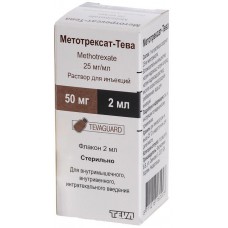Expiration date: 09/2026
Pharmacological action pharmacodynamic anticancer agent from the group of antimetabolites-folic acid antagonists. Acts In the s-phase of mitosis. The mechanism of action is associated with inhibition of the synthesis of purine nucleotides and thymidylate as a result of irreversible binding to dihydrofolate reductase, which prevents the restoration of dihydrofolate into active tetrahydrofolate. More active against fast-growing cells. It has some immunosuppressive effect.Pharmacokinetics slightly penetrates through the BBB (depending on the dose used). With intrathecal administration in a significant amount enters the systemic circulation. Binding to proteins (mainly albumin) plasma about 50%. Biotransformed in the liver. Excreted by the kidneys (unchanged) and bile (less than 10%). T1 / 2 depends on the dose used and has significant individual differences. When re-administration accumulates in the tissues in the form of metabolites.
Indications
- Acute lymphocytic leukemia,
- trophoblastic disease,
- skin cancer,
- cancer of the cervix and vulva,
- esophagus cancer,
- squamous cell head and neck cancer,
- cancer of the renal pelvis and ureters,
- osteogenic & soft cell sarcoma,
- ewing sarcoma,
- lung cancer,
- breast cancer,
- germ cell tumors of the testis and ovaries,
- liver cancer,
- kidney cancer,
- retinoblastoma,
- medulloblastoma,
- penile cancer,
- lymphogranulomatosis,
- severe forms of psoriasis (in case of failure of adequate therapy),
- severe form of rheumatoid arthritis (in case of failure of adequate therapy).
Contraindications
- Severe hepatic and/or renal impairment,
- leukopenia,
- thrombocytopenia,
- pregnancy,
- methotrexate should not be used in immunodeficiency conditions.


